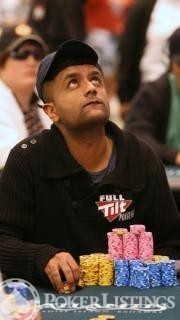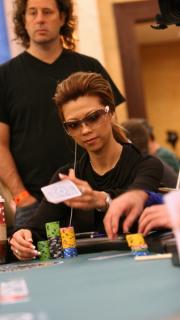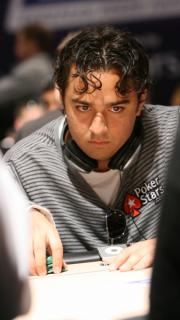06/05/2012 (2 years ago)
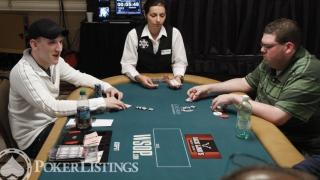
$10K Heads-Up: Somerville Dominates Froehlich Early

Bracelet winners Somerville and Froehlich face off in Round 2.
We picked up our coverage of the Jason Somerville vs. Eric
Froehlich match near the end of the first level (20-minute blind
levels), and Somerville had already gotten out to a solid lead.
Froehlich explained that Somerville also won an absurd number of the small-pot showdowns.
Each player began with an initial stack of 20,000, and two rebuy chips worth an additional 20,000 each that they could cash in any time except during a hand.
Jason Somerville - 45,300 (+2 rebuy chips)
Eric Froehlich - 14,700 (+1 rebuy chips)
Three hands later, after the blinds increased to 300-600, Somerville min-raised from the button to 1,200, and Froehlich called.
Both players check to the turn on a board of J♣ 9♦ 5♠ 7♦. Somerville bet 1,200, and Froehlich check-raised all in for 12,500. Somerville thought for a bit, and asked the dealer if he was allowed to show his cards.
The dealer said she'd have to call a floor, and Froehlich thought it wouldn't be allowed. Somerville said somebody showed him cards during the last heads-up event. (We got confirmation during the last event that showing cards was allowed, but stayed quiet as we are just observers.)
Somerville didn't ask for a floor, and folded, forfeiting the pot to Froehlich. Froehlich said he should've called if he had any outs at all, and then they discussed the value of top pair in that spot.
Felting Froehlich To His Last Bullet
Five hands later, Somerville min-raised the button to 1,200, and Froehlich called.
The flop came 9♦ 6♣ 3♠, Somerville bet 1,500, and Froehlich check-raised all in again, this time for 16,600. Somerville insta-called.
Froehlich showed 10♠ 9♥ for top pair, but Somerville dominated him with J♥ 9♠ for the same pair with a higher kicker.
The turn was the 8♥, giving Froehlich a gutshot straight draw, but the river was the 2♠, and Somerville won the pot. Froehlich was felted, and forced to cash in his last rebuy chip.
Jason Somerville - 60,000 (+2 rebuy chips)
Eric Froehlich - 20,000
Will Froehlich be able to mount a comeback against Somerville? Stay tuned.
Froehlich explained that Somerville also won an absurd number of the small-pot showdowns.
Each player began with an initial stack of 20,000, and two rebuy chips worth an additional 20,000 each that they could cash in any time except during a hand.
Jason Somerville - 45,300 (+2 rebuy chips)
Eric Froehlich - 14,700 (+1 rebuy chips)
Three hands later, after the blinds increased to 300-600, Somerville min-raised from the button to 1,200, and Froehlich called.
Both players check to the turn on a board of J♣ 9♦ 5♠ 7♦. Somerville bet 1,200, and Froehlich check-raised all in for 12,500. Somerville thought for a bit, and asked the dealer if he was allowed to show his cards.
The dealer said she'd have to call a floor, and Froehlich thought it wouldn't be allowed. Somerville said somebody showed him cards during the last heads-up event. (We got confirmation during the last event that showing cards was allowed, but stayed quiet as we are just observers.)
Somerville didn't ask for a floor, and folded, forfeiting the pot to Froehlich. Froehlich said he should've called if he had any outs at all, and then they discussed the value of top pair in that spot.
Felting Froehlich To His Last Bullet
Five hands later, Somerville min-raised the button to 1,200, and Froehlich called.
The flop came 9♦ 6♣ 3♠, Somerville bet 1,500, and Froehlich check-raised all in again, this time for 16,600. Somerville insta-called.
Froehlich showed 10♠ 9♥ for top pair, but Somerville dominated him with J♥ 9♠ for the same pair with a higher kicker.
The turn was the 8♥, giving Froehlich a gutshot straight draw, but the river was the 2♠, and Somerville won the pot. Froehlich was felted, and forced to cash in his last rebuy chip.
Jason Somerville - 60,000 (+2 rebuy chips)
Eric Froehlich - 20,000
Will Froehlich be able to mount a comeback against Somerville? Stay tuned.
06/05/2012 (2 years ago)
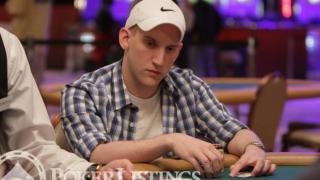
$10k Heads-Up: Somerville and Froehlich Win Feature Coverage

Jason Somerville takes center stage in our Round 2 coverage.
The votes have been tallied and the winners of our feature
coverage in Round 2 of this $10k Heads-Up Championship are Jason
Somerville and Eric Froehlich.
So far Jason Somerville has had the edge, forcing Froehlich to cash in one of his three re-buy chips. Our reporters are on the floor, cameras in hand, as we speak so we'll have more for you soon.
Players begin Round 2 with 20,000 in chips and blinds of 200/400. Levels are 20 minutes.
We'll also be keeping you up to date on the results of all the Round 2 matches so keep it locked right here.
So far Jason Somerville has had the edge, forcing Froehlich to cash in one of his three re-buy chips. Our reporters are on the floor, cameras in hand, as we speak so we'll have more for you soon.
Players begin Round 2 with 20,000 in chips and blinds of 200/400. Levels are 20 minutes.
We'll also be keeping you up to date on the results of all the Round 2 matches so keep it locked right here.
06/05/2012 (2 years ago)
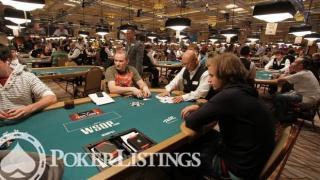
$10k Heads-Up: Twitter Voting Opens on Who To Cover in Round 2

Viktor Blom is through to Round 2.
Round 2 is about 15 minutes trick cards away and we’ve got the matchups for you to vote on.
If you’re just joining us we’re letting our readers tell us who they want to see covered.
Cast your vote by tweeting @PokerListings and the match that gets the most votes will receive feature coverage.
Get your votes in by 2pm for them to count.
Interesting Match-ups:
Here are the matches that stand out:
There are a few matches we're not 100% on. In those cases we've included the Round 1 matches.
If you’re just joining us we’re letting our readers tell us who they want to see covered.
Cast your vote by tweeting @PokerListings and the match that gets the most votes will receive feature coverage.
Get your votes in by 2pm for them to count.
Interesting Match-ups:
Here are the matches that stand out:
- Jason Somerville vs. Eric Froehlich
- Antonio Esfandiari vs. Isaac Haxton
- Vanessa Selbst vs. Scott Clements
- Olivier Busquet vs. Jonathan Jaffe
- Daniel Negreanu vs. Faraz Jaka
- Erik Seidel vs. Sam Stein
- Ben Lamb vs. Michael Mizrachi
- Phil Ivey vs. Manuel Bevand
- Viktor Blom vs. Tommy Chen
There are a few matches we're not 100% on. In those cases we've included the Round 1 matches.
- Tommy Chen vs. Viktor Blom
- Veerachai Vongxaiburana / Ben Tollerene vs. Ryan Leng
- Jason Somerville vs. Eric Froehlich
- Steve O'Dwyer vs. Yevgeniy Timoshenko
- Vojtech Ruzicka vs. Scott Baumstein
- Victor Ilyukhin vs. Chris Moorman
- Antonio Esfandiari vs. Isaac Haxton
- Jacob Godshall vs. Jason Mercier
- Josh Brikis vs. Richard Lyndaker
- Brian Green vs. Frank Kassela
- Matthew Perrins vs. Chris Moore
- Elior Sion / Helio Liberman vs. David Sands
- Martin Jacobson vs. Paul Volpe
- Victor Ramdin vs. Dimitar Danchev
- John Andress vs. Chae An
- Manuel Bevand vs. Phil Ivey
- Christiano Guerra vs. Shaun Deeb
- Igor Yaroshevskyy vs. James Dambrosio
- Ludovic Lacay vs. Leo Wolpert
- Amritraj Singh vs. Adam Ross
- Ari Goott vs. Melanie Weisner
- Tommy Vedes vs. James Akenhead
- Emil Patel vs. Matt Stout
- Brian Hastings vs. James Rumptz
- Vanessa Selbst vs. Scott Clements
- Jeffrey Kester vs. Robert Romanello
- Tom Marchese vs. Todd Barlow
- Kevin Saul vs. Ryan Fee
- Premsatya Kalevar vs. Darren Elias
- Bertrand "Elky" Grospellier vs. Steven Kelly
- Cary Katz vs. Leslie Duthie
- Jeff Gross vs. Sergey Tikhonov
- David Benefield vs. Steven Landfish
- Barry Woods vs. Christopher Jetten
- Olivier Busquet vs. Jonathan Jaffe
- Daniel Negreanu vs. Faraz Jaka
- Amit Makhija vs. Ryan O'Donnell
- George Wolff vs. Sean Winter
- James Collopy vs. Elton Beebe
- Andrew Robl vs. Christopher Wafula
- Justin Bonomo vs. John Riordan
- Andy Frankenberger vs. Evert Kokkonen
- Alexander Keating vs. Ronald Minnis
- Max Steinberg vs. Terrence Reinhart
- Erik Seidel vs. Sam Stein
- Steven Greenberg vs. Jason Mo
- Brandon Steven vs. George Lind
- Serkan Kurnaz vs. Harrison Kaczka
- Yin Sun vs. Moses Silverman
- Dan Smith vs. Moses Silverman
- Mark Radoja vs. Daniel Colman
- Ben Lamb vs. Michael Mizrachi
- Russell Rosenblum vs. Vladimir Shchemelev
- Andrew Lichtenberger vs. Markus Gonsalves
- Mohsin Charania vs. Douglas Polk
- Ashton Griffin vs. Ayaz Mahmood
- David Benyamine vs. Alexander Kuzmin
- John Juanda vs. Chou Chou
- Benjamin Sulsky vs. Michael Drummond
- Jake Cody vs. Yiming Li
- Tony Gregg vs. Stephen Chidwick
- Keith Block vs. Bryan Pellegrino
- Anthony Guetti vs. Andrew Manswer
- Randy Lew vs. Alexander Venovski
06/05/2012 (2 years ago)
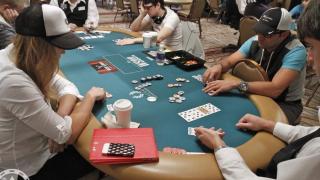
$10K Heads-Up: Antonio def. Vanessa; Isildur1 def. Bloch

Final Hand: Vanessa and Antonio got it all in on the turn.
The match between Antonio Esfandiari and Vanessa Rousso ended
shortly after our last update. With blinds at 400-800, all the rebuy
chips had been cashed in, and Esfandiari had a 37k-to-23k lead.
Rousso min-raised from the button to 1,600, and Esfandiari called to see a flop of J♠ 7♠ 7♣.
Rousso bet 2,000, Esfandiari check-raised to 5,200, and Rousso tanked for a while before she called.
The turn was the 8♣, and Esfandiari bet out 6,600. Rousso moved all in for about 16,000, and Esfandiari snap-called with 10♠ 7♦ (trip sevens). Rousso turned over J♣ 6♦ (two pair, jacks and sevens), and she'd need a jack on the river to stay alive.
The last card was the 5♥, and Esfandiari won the pot -- and the match -- with trip sevens. After a congratulatory handshake, Rousso disappeared while Esfandiari advances to Round 2, where he will face Isaac Haxton.
Viktor "Isildur1" Blom vs. Andy Bloch
Since the Esfandiari-Rousso match ended early, we switched over to the match that got the second-most votes in our Twitter poll.
Andy Bloch, who recently won his long-overdue first WSOP bracelet, was matched up in the first round against legendary-at-a-young-age Viktor Blom, better known as the ultra-high-stakes online player Isildur1.
Blom had already cashed in one of his rebuy chips, while Bloch still had both of his -- so there was 30,000 on the table, and they were relatively close in chips.
The first hand we saw was a big one.
Bloch limped for 800, and Blom checked his option. The flop came 9♣ 7♦ 2♠, Bloch bet 800, and Blom check-raised to 2,400. Bloch moved all in, and Blom called.
Bloch showed J♥ 9♦ (pair of nines), but Blom was in the lead with 7♥ 2♣ (two pair, sevens and deuces).
The turn was the A♦, the river was the 7♠, and Blom won the pot with a full house, sevens full of deuces. The stacks were counted, and Blom had more chips, so Bloch was felted and forced to reload.
 Bloch cashed in a single rebuy chip, and this is where they stood:
Bloch cashed in a single rebuy chip, and this is where they stood:
Viktor Blom - 30,000 (+1 rebuy chip)
Andy Bloch - 10,000 (+1 rebuy chip)
Over the next 12 hands, Blom increased his lead a bit and the blinds went up to 500-1,000.
Blom limped for 1,000, Bloch moved all in for 6,300, and Blom called with A♥ 8♥. Bloch showed 8♠ 7♠, and he was dominated.
The board came 10♦ 8♦ 4♦ 3♥ Q♦, and Blom won the pot with his ace kicker to felt Bloch again. So Bloch cashed in his last rebuy chip.
Viktor Blom - 40,000 (+1 rebuy chip)
Andy Bloch - 10,000
The very next hand, Bloch open shoved for 10,000, and Blom called with K♥ 7♥. Bloch turned over 10♣ 7♣, and laughed as he said, "Dominated again!"
The flop came Q♥ J♥ 3♠, and Bloch pointed out that Blom's hand improved even further, saying, "And a flush draw." The turn was the A♦, and Bloch said, "And a straight draw."
The river card was the 5♦, and Viktor Blom won the pot -- and the match -- with king high. Bloch got up to leave and said, "It's hard to win when you can't win an all in." Blom advances to Round 2, where he will face Tommy Chen.
Voting For Round 2 Will Open Soon
Once again, we will open up Twitter voting for who you'd like us to provide extensive coverage of during Round 2, which begins at 4:00 pm PT. We'll post those matchups soon, so stay tuned.
Rousso min-raised from the button to 1,600, and Esfandiari called to see a flop of J♠ 7♠ 7♣.
Rousso bet 2,000, Esfandiari check-raised to 5,200, and Rousso tanked for a while before she called.
The turn was the 8♣, and Esfandiari bet out 6,600. Rousso moved all in for about 16,000, and Esfandiari snap-called with 10♠ 7♦ (trip sevens). Rousso turned over J♣ 6♦ (two pair, jacks and sevens), and she'd need a jack on the river to stay alive.
The last card was the 5♥, and Esfandiari won the pot -- and the match -- with trip sevens. After a congratulatory handshake, Rousso disappeared while Esfandiari advances to Round 2, where he will face Isaac Haxton.
Viktor "Isildur1" Blom vs. Andy Bloch
Since the Esfandiari-Rousso match ended early, we switched over to the match that got the second-most votes in our Twitter poll.
Andy Bloch, who recently won his long-overdue first WSOP bracelet, was matched up in the first round against legendary-at-a-young-age Viktor Blom, better known as the ultra-high-stakes online player Isildur1.
Blom had already cashed in one of his rebuy chips, while Bloch still had both of his -- so there was 30,000 on the table, and they were relatively close in chips.
The first hand we saw was a big one.
Bloch limped for 800, and Blom checked his option. The flop came 9♣ 7♦ 2♠, Bloch bet 800, and Blom check-raised to 2,400. Bloch moved all in, and Blom called.
Bloch showed J♥ 9♦ (pair of nines), but Blom was in the lead with 7♥ 2♣ (two pair, sevens and deuces).
The turn was the A♦, the river was the 7♠, and Blom won the pot with a full house, sevens full of deuces. The stacks were counted, and Blom had more chips, so Bloch was felted and forced to reload.

This is 21-year-old Viktor Blom's first WSOP event, though he finished 16th in the 2010 WSOP-E Main Event.
Viktor Blom - 30,000 (+1 rebuy chip)
Andy Bloch - 10,000 (+1 rebuy chip)
Over the next 12 hands, Blom increased his lead a bit and the blinds went up to 500-1,000.
Blom limped for 1,000, Bloch moved all in for 6,300, and Blom called with A♥ 8♥. Bloch showed 8♠ 7♠, and he was dominated.
The board came 10♦ 8♦ 4♦ 3♥ Q♦, and Blom won the pot with his ace kicker to felt Bloch again. So Bloch cashed in his last rebuy chip.
Viktor Blom - 40,000 (+1 rebuy chip)
Andy Bloch - 10,000
The very next hand, Bloch open shoved for 10,000, and Blom called with K♥ 7♥. Bloch turned over 10♣ 7♣, and laughed as he said, "Dominated again!"
The flop came Q♥ J♥ 3♠, and Bloch pointed out that Blom's hand improved even further, saying, "And a flush draw." The turn was the A♦, and Bloch said, "And a straight draw."
The river card was the 5♦, and Viktor Blom won the pot -- and the match -- with king high. Bloch got up to leave and said, "It's hard to win when you can't win an all in." Blom advances to Round 2, where he will face Tommy Chen.
Voting For Round 2 Will Open Soon
Once again, we will open up Twitter voting for who you'd like us to provide extensive coverage of during Round 2, which begins at 4:00 pm PT. We'll post those matchups soon, so stay tuned.
06/05/2012 (2 years ago)
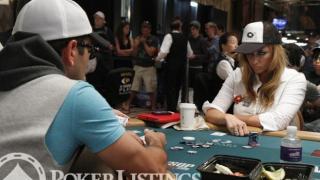
$10K Heads Up: Rousso Fights Back

Vanessa Rousso doubles up with queen-high
At the end of our last update, Antonio Esfandiari had Vanessa Rousso against the ropes. But she was keen on fighting back.
With 200/400 binds, Esfandiari raised to 1,000 from the small blind. Rousso called, bringing a 8♦ A♦ K♣ flop.
Esfandiari led out for 1,200 and Rousso raised to 2,400. A 9♦ came on the turn when Esfandiari called.
Rousso then checked again and Esfandiari threw a pile of yellow and blue chips, worth 8,500, into the pot.
This made Rousso think.
For a while.
She peeked at her cards multiple times and contemplated the bet, calling would put her all in. Rousso eventually called and showed Q♦ J♣ for a straight and a flush draw.
Her hand couldn't beat much, but it could definitely beat Esfandiari's 10♦ 7♥.
The river was a 5♠ and Rousso got the double up.
"You make me work for it, every time," Rousso said with a smile. "That was hard. It was really, really hard."
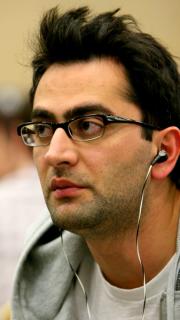 One For Esfandiari
One For Esfandiari
In the next level, with 300/600 blinds, Esfandiari raised to 1,400.
Rousso called and the flop came 4♣ K♣ Q♥. Rousso checked and Esfandiari led out for a small bet. Rousso responded by raising with stack of orange, 5,000 chips. Before Rousso's chips were done falling into the pot, Esfandiari called and showed K♥ J♥.
Rousso turned over a pair of kings of her own with K♦ 7♦. The turn was an 8♥ and a third heart, the 5♥, came on the river.
Esfandiari won the hand and Rousso was left with around 15,000.
A Few For Rousso
Esfandiari had now cashed marked cards in his rebuy tokens and all the chips were in play.
Rousso called from the small blind and Esfandiari checked.
There was a 7♦ 6♠ 2♠ flop and Rousso bet 1,000 when checked to. Esfandiari called and an A♣ came on the turn.
There was a round of checks and a 10♠ on the river. Esfandiari led out for 1,800 and Rousso called, showing 9♠ 7♣.
Her pair of 7s were enough to beat Esfandiari's J♠ 6♦.
A few hands later, Esfandiari raised to 1,500 from the button and Rousso called.
Rousso checked the 5♦ 3♣ 9♣ flop and Esfandiari bet 1,800. Rousso raised to 3,600 and a 5♥ came on the turn when Esfandiari called.
Rousso led out on the turn for 3,900 and Esfandiari folded.
When we left them, Rousso had worked her way up to 23,000 while Esfandiari had about 37,000.
To The Future
As we were posting this, we got word that Vanessa Rousso lost to Antonio Esfandiari. Due to this, we decided to watch Viktor Blom vs. Andy Bloch.
But Blom decided to win that match too.
Details of these two matches are coming up in our next post.
Stay tuned.
With 200/400 binds, Esfandiari raised to 1,000 from the small blind. Rousso called, bringing a 8♦ A♦ K♣ flop.
Esfandiari led out for 1,200 and Rousso raised to 2,400. A 9♦ came on the turn when Esfandiari called.
Rousso then checked again and Esfandiari threw a pile of yellow and blue chips, worth 8,500, into the pot.
This made Rousso think.
For a while.
She peeked at her cards multiple times and contemplated the bet, calling would put her all in. Rousso eventually called and showed Q♦ J♣ for a straight and a flush draw.
Her hand couldn't beat much, but it could definitely beat Esfandiari's 10♦ 7♥.
The river was a 5♠ and Rousso got the double up.
"You make me work for it, every time," Rousso said with a smile. "That was hard. It was really, really hard."

Antonio Esfandiari
In the next level, with 300/600 blinds, Esfandiari raised to 1,400.
Rousso called and the flop came 4♣ K♣ Q♥. Rousso checked and Esfandiari led out for a small bet. Rousso responded by raising with stack of orange, 5,000 chips. Before Rousso's chips were done falling into the pot, Esfandiari called and showed K♥ J♥.
Rousso turned over a pair of kings of her own with K♦ 7♦. The turn was an 8♥ and a third heart, the 5♥, came on the river.
Esfandiari won the hand and Rousso was left with around 15,000.
A Few For Rousso
Esfandiari had now cashed marked cards in his rebuy tokens and all the chips were in play.
Rousso called from the small blind and Esfandiari checked.
There was a 7♦ 6♠ 2♠ flop and Rousso bet 1,000 when checked to. Esfandiari called and an A♣ came on the turn.
There was a round of checks and a 10♠ on the river. Esfandiari led out for 1,800 and Rousso called, showing 9♠ 7♣.
Her pair of 7s were enough to beat Esfandiari's J♠ 6♦.
A few hands later, Esfandiari raised to 1,500 from the button and Rousso called.
Rousso checked the 5♦ 3♣ 9♣ flop and Esfandiari bet 1,800. Rousso raised to 3,600 and a 5♥ came on the turn when Esfandiari called.
Rousso led out on the turn for 3,900 and Esfandiari folded.
When we left them, Rousso had worked her way up to 23,000 while Esfandiari had about 37,000.
To The Future
As we were posting this, we got word that Vanessa Rousso lost to Antonio Esfandiari. Due to this, we decided to watch Viktor Blom vs. Andy Bloch.
But Blom decided to win that match too.
Details of these two matches are coming up in our next post.
Stay tuned.
06/05/2012 (2 years ago)
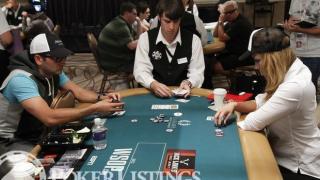
$10K Heads-Up: Antonio Has Vanessa Down to One Bullet

Antonio takes the early lead.
After tallying your Twitter votes, the first-round match that
@PokerListings followers chose was between Antonio Esfandiari and
Vanessa Rousso.
Each player began with an initial stack of 10,000, and had two rebuy chips they could cash in at any time (except during a hand) for an additional 10,000 each. The blinds began at 100-300.
We began our coverage at 1:00 pm, about six minutes into their match. By that point, Rousso built up an early lead, but then Esfandiari doubled after a flop of 10♣ 9♠ 4♦.
Rousso had K♦ 4♣ (pair of fours), but Esfandiari was ahead with Q♥ 9♥ (pair of nines). The turn was the 6♥, the river was the 5♣, and Esfandiari doubled into the early lead.
Soon after that, Rousso min-raised to 600, and Esfandiari raised to 1,800. Rousso thought for a bit before she called, because it was a significant amount of her stack.
The flop came K♥ 8♥ 5♠, and Esfandiari bet 3,300. Rousso tanked for well over a minute, as she only had 4,700. Rousso eventually folded, and Esfandiari opened up a 3-to-1 chip lead.
The next hand, Esfandiari raised to 800, Rousso moved all in for 4,700, and Esfandiari quickly called with 5♣ 5♥. Rousso showed J♦ 7♦, and it was a race situation.
The board came A♦ Q♥ 2♦ K♠ 6♣ -- Rousso flopped a diamond flush draw, turned a gutshot straight draw, but missed all her outs and finished with jack high. Esfandiari claimed the rest of her initial stack.
Down to the felt, Rousso cashed in both of her rebuy chips to even things up.
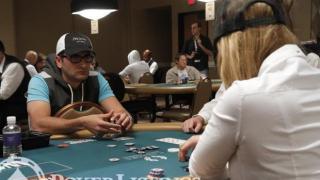
Antonio Esfandiari - 20,000 (+2 rebuy chips)
Vanessa Rousso - 20,000
Vanessa Cashes in Both Chips
After cashing in her two rebuy chips, Rousso went on a minor run, winning eight of the next nine hands to build a small lead before the blinds increased to 200-400.
Vanessa Rousso - 25,800
Antonio Esfandiari - 14,200 (+2 rebuy chips)
The two players had been silent to this point, but began talking when Rousso asked, "So, how's everything going?" They chatted for a while, and Esfandiari was amazingly positive, saying, "For the first time in my life, I'm truly at peace with myself."
They chatted during two small pots before playing a big one.
Rousso limped from the button for 400, Esfandiari raised to 1,400, and Rousso called. The flop came 10♠ 9♣ 4♥, Rousso bet 2,000, and Esfandiari called.
The turn was the 2♦, Rousso bet 5,500, and Esfandiari check-raised all in for 11,400. Rousso tanked for a while, studying Esfandiari before she called with 4♦ 3♦ (pair of fours).
But Esfandiari turned over 8♣ 8♥. The river was the Q♥, and Esfandiari doubled up with his pocket eights.
Antonio Esfandiari - 29,600 (+2 rebuys)
Vanessa Rousso - 10,400
Our coverage will continue for as long as they do, so stay tuned for more updates on Antonio Esfandiari vs. Vanessa Rousso.
Each player began with an initial stack of 10,000, and had two rebuy chips they could cash in at any time (except during a hand) for an additional 10,000 each. The blinds began at 100-300.
We began our coverage at 1:00 pm, about six minutes into their match. By that point, Rousso built up an early lead, but then Esfandiari doubled after a flop of 10♣ 9♠ 4♦.
Rousso had K♦ 4♣ (pair of fours), but Esfandiari was ahead with Q♥ 9♥ (pair of nines). The turn was the 6♥, the river was the 5♣, and Esfandiari doubled into the early lead.
Soon after that, Rousso min-raised to 600, and Esfandiari raised to 1,800. Rousso thought for a bit before she called, because it was a significant amount of her stack.
The flop came K♥ 8♥ 5♠, and Esfandiari bet 3,300. Rousso tanked for well over a minute, as she only had 4,700. Rousso eventually folded, and Esfandiari opened up a 3-to-1 chip lead.
The next hand, Esfandiari raised to 800, Rousso moved all in for 4,700, and Esfandiari quickly called with 5♣ 5♥. Rousso showed J♦ 7♦, and it was a race situation.
The board came A♦ Q♥ 2♦ K♠ 6♣ -- Rousso flopped a diamond flush draw, turned a gutshot straight draw, but missed all her outs and finished with jack high. Esfandiari claimed the rest of her initial stack.
Down to the felt, Rousso cashed in both of her rebuy chips to even things up.

Antonio has the advantage.
Antonio Esfandiari - 20,000 (+2 rebuy chips)
Vanessa Rousso - 20,000
Vanessa Cashes in Both Chips
After cashing in her two rebuy chips, Rousso went on a minor run, winning eight of the next nine hands to build a small lead before the blinds increased to 200-400.
Vanessa Rousso - 25,800
Antonio Esfandiari - 14,200 (+2 rebuy chips)
The two players had been silent to this point, but began talking when Rousso asked, "So, how's everything going?" They chatted for a while, and Esfandiari was amazingly positive, saying, "For the first time in my life, I'm truly at peace with myself."
They chatted during two small pots before playing a big one.
Rousso limped from the button for 400, Esfandiari raised to 1,400, and Rousso called. The flop came 10♠ 9♣ 4♥, Rousso bet 2,000, and Esfandiari called.
The turn was the 2♦, Rousso bet 5,500, and Esfandiari check-raised all in for 11,400. Rousso tanked for a while, studying Esfandiari before she called with 4♦ 3♦ (pair of fours).
But Esfandiari turned over 8♣ 8♥. The river was the Q♥, and Esfandiari doubled up with his pocket eights.
Antonio Esfandiari - 29,600 (+2 rebuys)
Vanessa Rousso - 10,400
Our coverage will continue for as long as they do, so stay tuned for more updates on Antonio Esfandiari vs. Vanessa Rousso.
06/05/2012 (2 years ago)

$10K Heads Up: Rousso Wins First Round Elections

The will of the people leads us to Vanessa Rousso
Right now, the walkway in the Brasilia room is a poker fan's dream.
Most of the best poker players in the world are crammed into a 50-ft walkway awaiting the table draw for the 2012 $10K Heads-Up Championship.
To make it to the center of the Brasilia room, you have to push your way through the likes of Elky, Viktor Blom and Jason Mercier. Some areas are so tight you have to squeeze past Vanessa Rousso and Vanessa Selbst.
If you get lost in the crowd, you might end up eavesdropping in on a conversation between Justin Bonomo, Shawn Buchanan, Eric Froehlich and Brock Parker.
There are online poker room patches and strategy talks sprinkled among the crowd. There's even an enthusiastic, baseball cap-wearing poker fan bouncing between pros, asking for autographs.
He has a binder filled with pictures of poker pros that now surround him; there's a huge smile on his face too, it looks like he's having a good day.
Fans are an essential part of poker. They bring prominence to the sport and keep us media folks employed.
So today, we'll also be catering to poker fans.
There are several big names in the field today, and we asked you which ones you wanted us to follow.
After a highly-democratic Twitter election, you chose:
Vanessa Rousso vs. Antonio Esfandiari
We'll be covering them for this match, and don't forget to vote for your favorite players during the next round.
Most of the best poker players in the world are crammed into a 50-ft walkway awaiting the table draw for the 2012 $10K Heads-Up Championship.
To make it to the center of the Brasilia room, you have to push your way through the likes of Elky, Viktor Blom and Jason Mercier. Some areas are so tight you have to squeeze past Vanessa Rousso and Vanessa Selbst.
If you get lost in the crowd, you might end up eavesdropping in on a conversation between Justin Bonomo, Shawn Buchanan, Eric Froehlich and Brock Parker.
There are online poker room patches and strategy talks sprinkled among the crowd. There's even an enthusiastic, baseball cap-wearing poker fan bouncing between pros, asking for autographs.
He has a binder filled with pictures of poker pros that now surround him; there's a huge smile on his face too, it looks like he's having a good day.
Fans are an essential part of poker. They bring prominence to the sport and keep us media folks employed.
So today, we'll also be catering to poker fans.
There are several big names in the field today, and we asked you which ones you wanted us to follow.
After a highly-democratic Twitter election, you chose:
Vanessa Rousso vs. Antonio Esfandiari
We'll be covering them for this match, and don't forget to vote for your favorite players during the next round.
06/05/2012 (2 years ago)
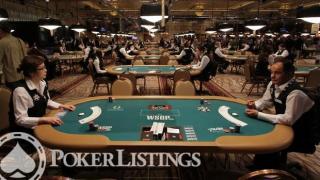
$10k Heads-Up: Bracket Set, Voting on Twitter Now Open

Dealers await players.
The bracket for this year’s Heads-Up Championship has been set
and we’re opening the voting right now to let you decide who we’ll cover
in Round 1.
152 players bought into this event but because of the heads-up format, a bracket for 256 had to be created.
Because of that, 104 players received byes in Round 1.
That means roughly 66 percent of the field will automatically advance to Round 2. It also means that Round 2 will have more matches than Round 1.
Check out the matches below and vote @PokerListings on Twitter for the next 15 minutes to tell us who to cover.
152 players bought into this event but because of the heads-up format, a bracket for 256 had to be created.
Because of that, 104 players received byes in Round 1.
That means roughly 66 percent of the field will automatically advance to Round 2. It also means that Round 2 will have more matches than Round 1.
Check out the matches below and vote @PokerListings on Twitter for the next 15 minutes to tell us who to cover.
- Viktor Blom vs. Andy Bloch
- Josh Brikis vs. Juan Ramirez
- Joseph Cheong vs. Jacob Godshall
- Eric Froehlich vs. Ronald Crabtree
- Antonio Esfandiari vs. Vanessa Rousso
- Jason Koon Vs. Brian Green
- Yevgeniy Timoshenko vs. James Guinther
- Isaac Haxton vs. Daniel Morgan
- Sam Trickett vs. Victor Ilyukhin
- Frank Kassela vs. Aaron Jones
- Dan Kelly vs. Ryan Leng
- Steve O'Dwyer vs. Kunimaro Kojo
- Chris Moore vs. Matt Marafioti
- Jason Mercier vs. Steven Silverman
- Chris Moorman vs. Andrew Rosskamm
- David Sands vs. Jaspreet Panchhi
- Todd Terry vs. Vojtech Ruzicka
- Jason Somerville vs. Justin Smith
$10k Heads-Up: Tell Us Who to Cover Via Twitter
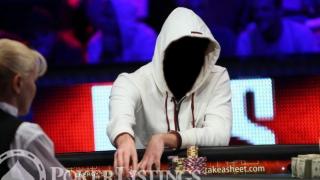
Today you can choose who we cover using Twitter.
The $10,000 Heads-Up Championship begins today and
PokerListings.com is introducing a brand new style of coverage to get
you closer to the action.
The WSOP staff will set the bracket at noon today and we'll post the matches right here.
Then all you have to do is Follow us on Twitter and tweet which match you want us to cover from beginning to end.
Our sources tell us that Viktor "Isildur1" Blom is now in Las Vegas and will likely be playing today's $10k event so if you want to see all Blom all the time, make sure to vote.
This is the first $10k event of 2012 which means the pros are going to be out in force.
Phil Ivey, Daniel Negreanu, Phil Hellmuth and many more will be battling it out for the first championship bracelet of the summer so give us a hand and let us know who you want to see in the coverage.
Hit us back at noon and get involved in the vote.
The WSOP staff will set the bracket at noon today and we'll post the matches right here.
Then all you have to do is Follow us on Twitter and tweet which match you want us to cover from beginning to end.
Our sources tell us that Viktor "Isildur1" Blom is now in Las Vegas and will likely be playing today's $10k event so if you want to see all Blom all the time, make sure to vote.
This is the first $10k event of 2012 which means the pros are going to be out in force.
Phil Ivey, Daniel Negreanu, Phil Hellmuth and many more will be battling it out for the first championship bracelet of the summer so give us a hand and let us know who you want to see in the coverage.
Hit us back at noon and get involved in the vote.
